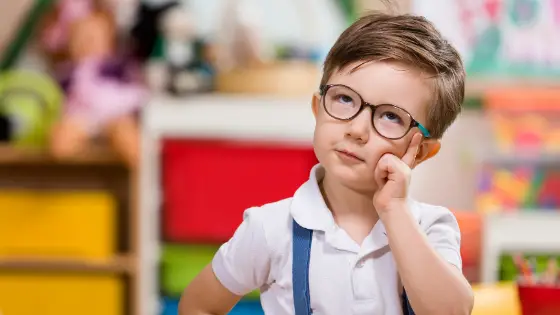Are you looking for some fun preschool songs or games to play with instruments?
In my second year of teaching, I was approached by my school’s preschool teachers and asked to teach music.
I had some idea of what to do with them, but I wanted to include more instruments at their level.
So I asked around, did some research, and came up with these 7 preschool music activities with instruments.
Preschool music with instruments doesn’t have to be scary. Use non-pitched percussion to practice steady beat, and you’ll do just fine. My favorite activities include:
- Froggy In The Meadow
- Bow Wow Wow
- Play, Play, Play The Drum
- Twinkle, Twinkle Little Star
- Drumming With Glow Sticks
- Johnny Works With One Hammer
- Timbre Dance
Read ahead for instructions on how to play these games and some of my favorite resources you may want to check out.

Save time with these 60 FREE Music Resources to use in your room right away!
Stop searching the whole internet to find good activities. I’ll help you cut to the chase with my favorite 60 FREE resources.
Table of Contents
7 Preschool Music Games With Instruments
Here are 7 of my favorite preschool music activities to do with instruments (you may also enjoy some distance learning in music resources). Some of these are built around a song while others can be adapted for any song or recording.
Note: All of these activities will work just as well with Kindergarten or First grade students.
#1 Froggy In The Meadow
This is one of my personal all-time favorite songs for any of the younger grades, but especially preschool.
Every year for the past 5 years now, I volunteer in my own childrens’ preschool on their birthday, and I always do this song.
The game is a simple one: think of different ways to “stir” the froggy to the beat. I usually end it with bobbing our tongues to the beat.
Even shy kids will burst out in song if they can do it while their tongues are sticking out.
For adding instruments, it doesn’t take much to transfer this beat practice instruments of various kinds.
Because the students may already know this one so well, the instrument playing is often successful right away.
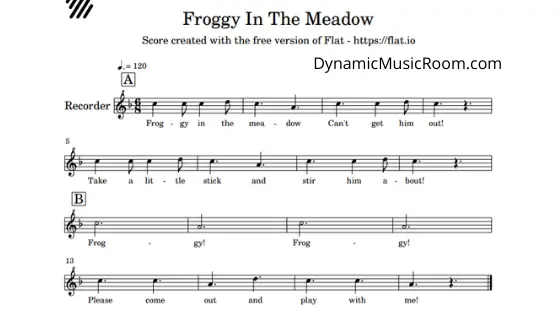
#2 Bow Wow Wow
With older kids, this song is great for quarter rest or introducing solfege, do.
With preschoolers, this song is just good fun with an easy way to add instruments.
After you teach it using your favorite approach (see below), ask students to play different instruments during the rest (or quiet spots as I call them in preschool).
If they play when they’re not supposed to, they’re out.
I speed up the song to make it more difficult, and it gets to be a lot of fun.
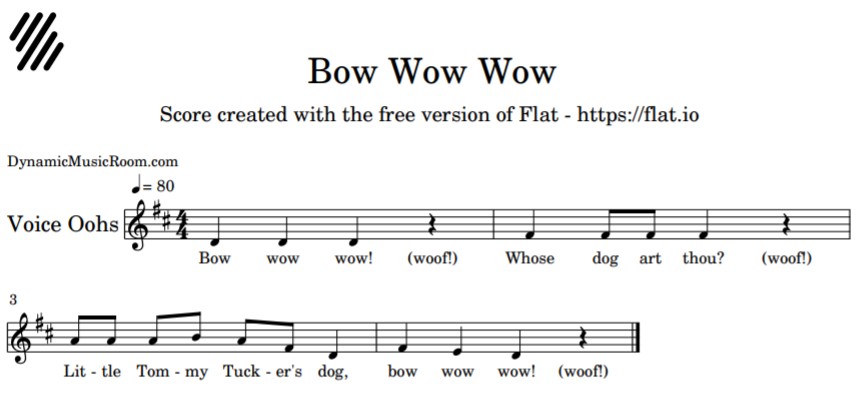
#3 Play, Play, Play The Drum
This song is simple, but with preschool, there’s nothing wrong with that.
We usually just play the beat and change the name of the instrument to match what we’re playing.
This is great for learning the names of the non-pitched (or pitched if you can get a do-sol fifth going one) instruments. After a time, you’ll never hear a maraca called a tambourine again!
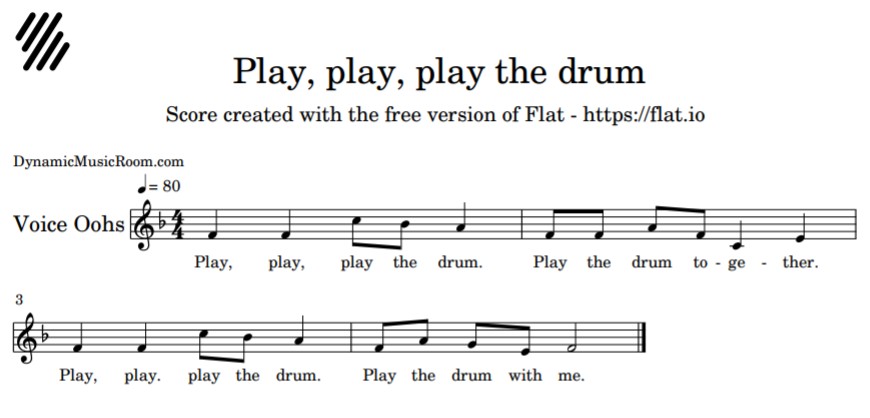
#4 Twinkle Twinkle Little Star
There are two ways I tend to include instruments with this song in preschool.
Beat practice – Students practice the beat matching the song (which is usually pretty easy because the song is mostly quarter notes anyway).
Timbre practice – Point out important words in the song such as “star” and “twinkle,”
Ask students which instruments they think would be best fit those words.
Sing the song and have the instruments play on those words.
It helps if you write the words and draw a picture of the instrument that plays at the right spot. Then, point at the words as they sing.
(It also helps with reading fluency even if the kids can’t read!)
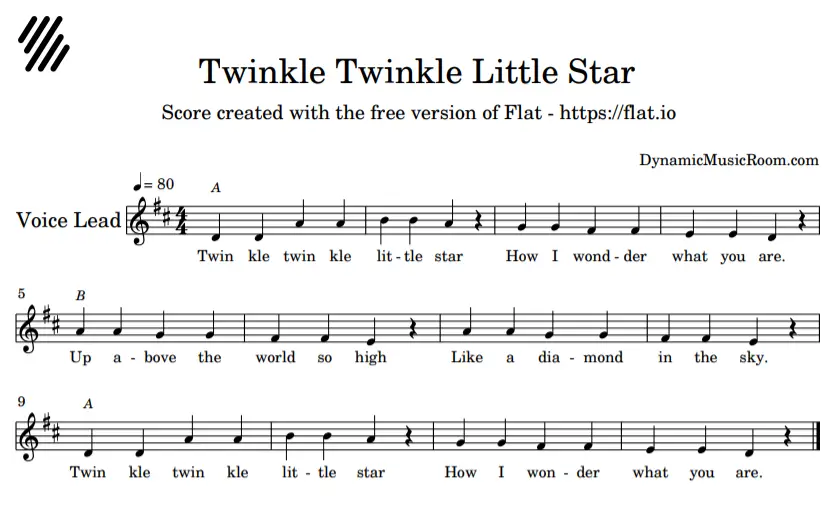
#5 Drumming With Glow Sticks
This activity isn’t tied to a specific song or recording, but the activity may be transferred to anything including other songs on this list.
The activity is just like the name sounds: students play the beat on drums using glow sticks.
You can buy them at most party stores or dollar stores for cheap and in bulk.
One of my favorite recordings to do this with is Hungarian Dance No. 5. Just watch out for the tempo changes!
#6 Johnny Works With One Hammer
This song is one of the earliest songs many music teachers use in Kindergarten. I usually use it on the very first day.
But this song also works well with preschoolers in a similar manner.
By itself, the “game” of adding motions is a blast for kids.
The beat itself is fun to play along with any number of instruments.
As a bonus, this sounds features swung eighth notes (or quarter-eighth in triple if you prefer) which is sometimes ignored with kids songs.
The moves go like this:
- 1 = right hand patting
- 2 = right and left hand patting
- 3 = add right foot tapping
- 4 = add left foot tapping
- 5 = add head bobbing
Pro-tip: Encourage creativity by asking the students to create new motions.
Check out the notation at SingSolfa.com.
#7 Timbre Dance
This activity doesn’t need a song or recording at all, but if you wanted to add one, you definitely could.
For this activity, the teacher picks move matching an instrument.
For example:
- Drum = stomp
- Egg shakers = wiggle
- Tambourines = skip
Students could also help the teacher create the moves too.
The students need to match the move to the instrument playing. In this way, their ears become more sensitive to timbre.
I usually start with me playing the instruments. As time goes on, you may wish to turn the instruments over to a few individuals you rotate through.
For a good song to move with, I like Happy by Pharrel Williams.
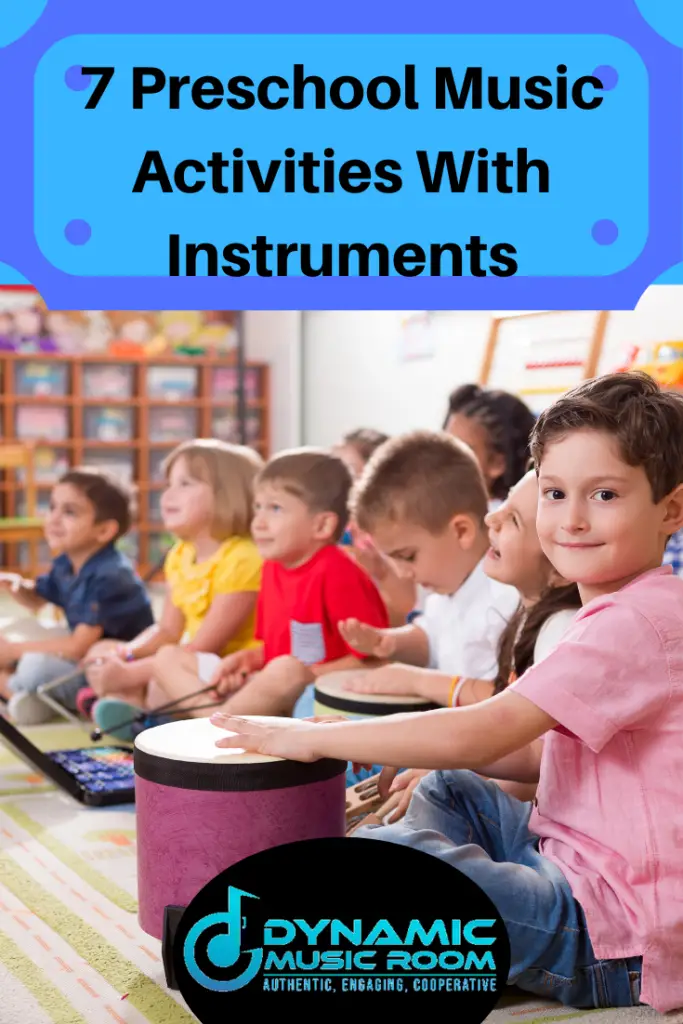
How Do You Introduce Music To Preschoolers?
There are two basic ways to introduce any song to kids: whole song approach and rote song approach.
Whole Song Approach
The whole song approach is essentially repeating songs until the students have learned it through experience.
With this approach, you’re giving the students something to do or listen for while you sing the song 3-5 times.
Then, you ask them to sing it.
If they can’t, no problem. Either repeat the process while asking students to do something else or just come back another day.
This method is generally shown to be very effective with simple songs and more difficult with songs that are longer with multiple phrases.
Example:
Take the simple song, Bow Wow Wow.
- While you sing, ask students to count how many times you put your ears down (on the quarter rest).
- You sing again; ask students to match your movements.
- Ask students to clap on the quiet spots this time.
- Ask students to bark “woof” on the previously quiet spots.
- Ask a volunteer for a different idea of how to bark.
- Repeat 3-5 more times.
- Ask students to try to sing the song.
- If they can’t, no problem. Try again another class.
- If they, add instruments or add instruments another class.
Rote Song Approach
The rote song approach involves a whole-part-whole learning approach.
First, students hear the song in its whole form. This step may be repeated a few times.
Then, students echo you as you break down the song, phrase by phrase.
If needed, you piece multiple phrases together into larger chunks.
Finally, students put the whole song together.
This approach is generally considered to be best when teaching songs that are longer and have multiple phrases. It’s usually deemed unnecessary with short and simple songs.
Example:
Take the song, Twinkle Twinkle Little Star. (Note: I wouldn’t normally use this approach with this well-known song, but it works well for demonstration purposes.)
- Whole: Ask students to pat the beat while you sing the whole song.
- Whole: Repeat 1-2 times with different beats.
- Part: Students echo first 4 measures.
- Part: Students echo measures 5-8.
- Whole: Students sing the whole song.
Which Should I Use In Preschool?
I believe that for preschool kids, the whole song approach is the best.
Most of the songs are so simple and short you won’t need to break it down. In fact, breaking it down seems to make it harder to connect when trying to put simple songs back together.
Favorite Preschool Music Instruments And Resources
Still looking for more preschool music things? Here are a few of my favorite instruments and resources for preschool.
Links to products are affiliate in nature which means I earn a small commission if you click and purchase at NO extra cost to you. However, I do use these resources and believe in their usefulness.
Best Preschool Instruments
Egg Shakers – Egg shakers are perfect for kids hands and come in a variety of fun colors. Make sure you get ones that don’t break easily like these.
Otherwise, it makes a huge mess! Trust me.
Hand Drums – Hand drums work better than other types, in my opinion, because they’re held up for better sound and really durable. These fit inside each other for easy storage.
Gathering Drum – The big gathering drum is great for bringing kids together at one place and help them reinforce the beat with each other. And, honestly, they think it’s pretty cool to play such a big drum.
Tambourines – Any tambourines will do, but I like these because of their good sound and easy-to-hold handle.
Rhythm Sticks – Rhythm sticks are great for playing beat and rhythm in young grades. There are better ones out with a better sound, but these are great for preschool.
They’re a lot more durable and the plastic won’t give splinters.
Favorite Preschool Music Resources
First Steps In Music For Preschool And Beyond – This curriculum by John Feierabend is thorough and musically appropriate for this age group if you’re looking for an all-around program.
101 Rhythm Instrument Activities For Young Children – For those who want more instrument activities, this book is jam-packed.
After a while, many of the activities are similar, but if you just want a huge source to pull from, this is it.
Shake, Rattle, And Roll – This book series will help the music teacher, but it’s also great for preschool teachers. Along with music, this book includes many cross-curricular activities.
Conclusion
I hope these 7 preschool music activities with instruments is helpful to you. I picked ones I thought anyone could use in their classrooms right away.
Which one are you most interested in trying out? Pop on down to the comments and let us know.

Save time with these 60 FREE Music Resources to use in your room right away!
Stop searching the whole internet to find good activities. I’ll help you cut to the chase with my favorite 60 FREE resources.

